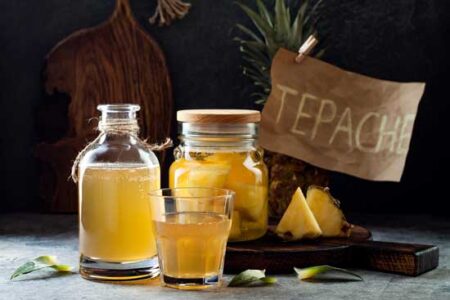GettyImages/BONDART
Dark rum was the first distilled spirit I attempted to make. It’s David’s favorite kind of liquor, and he is fond of adding it to his morning hot cocoa, as well as in classic drinks like the Cuba Libre. To tell the truth, one of the reasons I started with rum is because I wasn’t very confident at the time about my mashing skills, and I had learned that making rum mainly involved dissolving molasses in hot water, then fermenting and distilling it. How hard could it be, right?
I was fortunate to obtain organic blackstrap molasses at whole sale prices through our chef friend Gabriel. It comes in a bucket of a little over 50 pounds, and my records indicate that one such bucket produced about 11 bottles of beautiful, flavorful rum at 40% ABV.
Ingredients
- 0.5 gallon (2 L) molasses (sweet or blackstrap molasses, but make sure it’s unsulphured)
- 2.6 gallons (10 L) hot tap water
- 1.3 gallons (s L) cold tap water
- 1 ounce (30 ml) distiller’s yeast or 1 package distiller’s yeast/ enzyme combination
Process
Pour the molasses into a clean fermenting bucket. Add the hot tap water and stir until the molasses is dissolved. Add the cold tap water and stir well. I find that after I add the cold water, the wash is usually 32°C/90°F, just about the right temperature to add the yeast. (Be sure to check the temperature of the wash before adding the yeast, though; the temperature of hot tap water can vary.) Check and record the specific gravity of the wash; this concentration of molasses typically gives me an OG of1.060. Stir in the yeast. Put the lid on the bucket, add cool water to your airlock and put the airlock in place. Label the lid with the contents and the date. Ferment 48 to 72 hours in a warm place; the fermentation should have slowed way down by the third day.
Since I ferment the wash in my house and distill in the stillhouse, I like to carry the fermenting bucket to the stillhouse the day before I plan to distill it. This gives the wash a chance to settle after being jostled around and mixed up a bit en route. Then I siphon the liquid off the yeast sediment into the still. Before I put the lid back on the boiling pot, I calculate the alcohol content of the wash and record that number.
Distilling Rum
Do a beer-stripping run first. Record the quantity and ABV of the low wines collected. When you are ready to do your spirit run, make sure the needle valve of the still is wide open. I like to distill rum using the pot still method, which results in a rum of deeply satisfying flavor and body.
I have gotten the best results when I collect the heads until the distillate is down to 80% ABV. Switch to the hearts and collect them until the distillate is down to 65% ABV. The second time I distilled rum, I tried waiting to make the end-cut until the distillate was down to 60% ABV. Everything else about the batch was exactly the same as the first, except for the end-cut, but the resulting spirit was noticeably different-not in a good way. It’s hard to describe the change accurately, but to me the flavor was somehow “thinner” and seemed to be missing some of the deep caramel tones so evident in the first batch. In addition, a couple of people who drank some of this second batch reported having a bit of a headache the next day! Not good at all.
So take my advice, don’t be greedy and try to get just a little bit more out of that hearts run. Do experiment with small batches and be sure to keep detailed records of what you did and what the results were. Oh, and keep in mind that you may get somewhat different results with your still than I get with mine; you may also find that using a different type of yeast makes a big difference. Play with it and have fun, but do keep those records. You’ll be glad you did.
Since this was the first thing I ever distilled, I had no idea what I was doing as far as aging it. I did my best to char some oak chips, took a guess at how much to put in the jar with the rum, and then took more guesses as far as how long to let it sit in there. I left it for about three months, after which it was a beautiful golden color, and had an aroma reminiscent of a honey-scented whiskey. It was so smooth it was lovely to just sip on its own.
Beginner’s luck, no doubt, but I have to admit it did bolster my confidence heading into the next project.
More from Craft Distilling
Excerpted with permission from Craft Distilling by Victoria Redhed Miller, Published by New Society Publishers.









